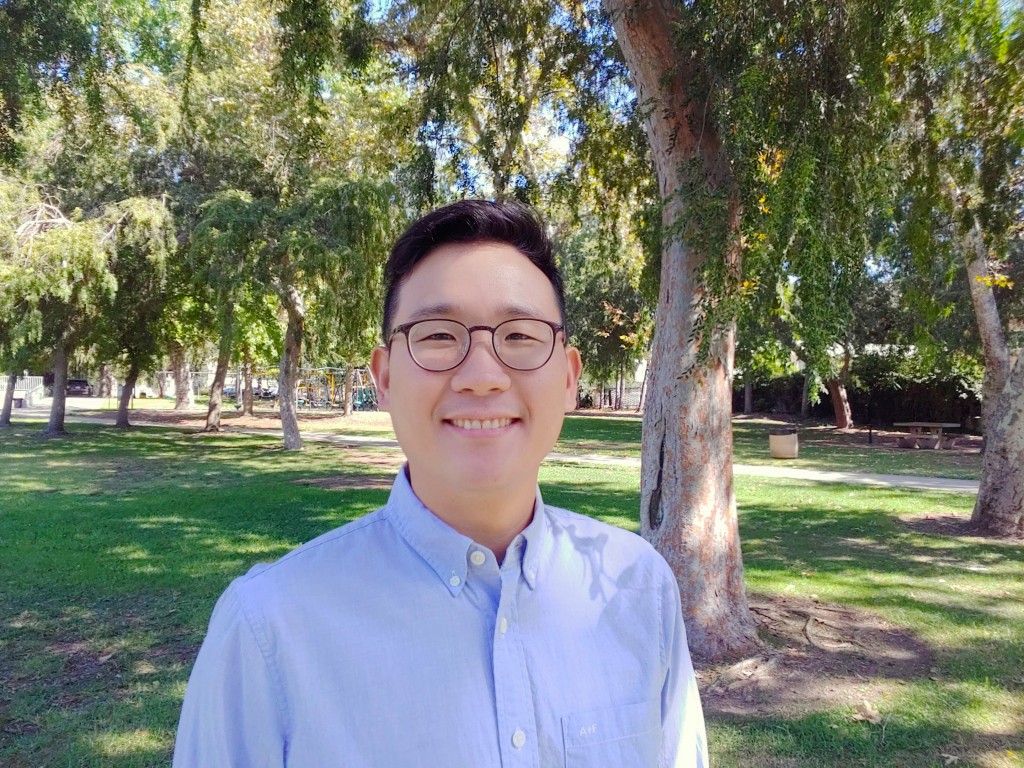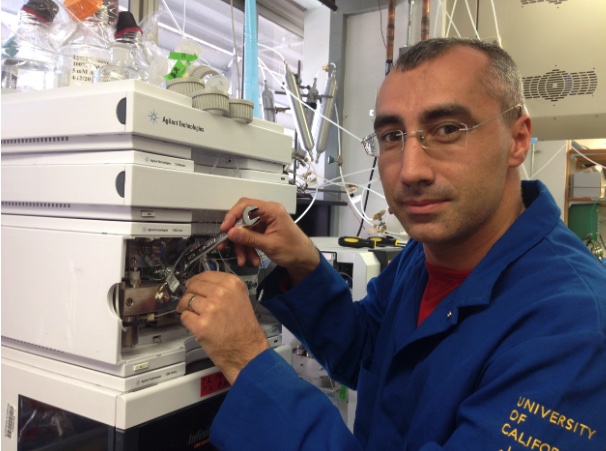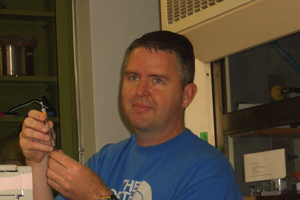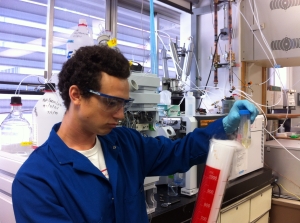Adrian Gomez, Ph.D
Alexander Yoon, M.S.
–
Johnathan Katz, PhD
I owe my entire post-graduate career to my time incarcerated in the PMSL. Technically speaking, I was on a work furlough during my graduate career with a split sentence between the PMSL and the Chemistry department at UCLA, irrespectively, I simply cannot overstate the value of the incredible resource that is the PMSL. As collaborators, it is a conglomerate of talent. As a teaching facility, it is a welcoming enriching environment that rarely exists.
I came to the PMSL because my graduate thesis research led me to questions that ultimately were best answered by mass spectrometry. But I LEARNED mass spectrometry because when I first entered the lab instead of being met with a recharge form and an immediate demand for money, I was instead offered a cup of tea, a key to the facility, and training. “Fee for service” was of course possible, but, I did not have the money initially because I did not have any pilot data that would support the funding. And so, after a bit of training, I was allowed to use the instrumentation (after hours when the “fee for service” and obligated grant work was done) and ultimately ended up with a few publications (some of which included funding) and a graduate degree and a skillset and mindset that has shaped my science and career throughout the decades. I cannot stress this enough — the directors and staff of the PMSL were more interested in teaching me how to get my own data than in getting funding from me and doing it themselves. There is simply not a better model for core facility operation at a research/teaching university. If I was not vegetarian, I would include some adage about fishing…
Kym Faull & Julian Whitelegge have remained collaborators and mentors to me to this day. I employ the skills that I learned at the PMSL under their guidance as Faculty at the Keck School of Medicine of USC and the Lawrence J Ellison Institute for Transformative Medicine.
–
Kriss Webb
The Pasarow Mass Spectrometry Laboratory was an essential component of my graduate career. My work in the PMSL was from 2004 to 2010 and centered on intact protein mass spectrometry, Top-down/bottom-up proteomics, and protein post-translational modifications. The PMSL is a unique resource lacking at many universities. Unlike a traditional “fee for service” core laboratory, the focus is on teaching the fundamental principles of analytical chemistry and biological mass spectrometry. Kym and Julian both have a passion for teaching. Instead of delivering a dataset, they provided me the understanding and skillset to develop experimental approaches to collect my data and the opportunity to operate a wide range of instrumentation independently. I use this knowledge daily and try to emulate the PMSL learning environment in my current laboratory. Without the guidance I received during my training under Kym and Julian, I would not be in the position I am today at Pfizer oncology research and development. Thank you both for all that you do.
–
Lin Hwang
Lin first started his time at the PMSL in the summer of 2014 as a volunteer research assistant after completing his undergraduate studies at UCLA. He was hired as a lab technician from 2015-2016 and primarily worked on the Agilent 6460 LC-MS systems. He then left for medical school at Western University of Health Sciences (class of 2020) and is currently completing his diagnostic radiology residency at Geisinger Medical Center in Pennsylvania. He views his time at the PMSL fondly and is grateful for the mentorship and many wonderful memories.
–
During the summer of 2013, Andrei Rajkovic had a short, but productive stint at the Kym Faull et al laboratory. He came from Michael Ibba’s lab in search of an unknown post-translational modification (PTM) on an esoteric bacterial translation factor known as EF-P. He spent many nights, sometimes even sleeping in the corridor between labs, learning to operate the old, but trusty SCIEX III API. It was on that instrument that he caught a glimpse of two never before seen PTMs. After cutting his gums on the SCIEX, he moved on to higher resolution instruments to characterize the elemental composition of the additional mass found on his proteins. These critical observations ultimately led him to structurally decode the nature of those PTMs. Most importantly, he made great friends, Pascal Liauw, Thuc Lee, Farbod Fazlollahi and Joe Capri while being there. All of them shared the same strong passion for discovery and were drawn to the powers of how fast the mass spec could deliver highly accurate data. Andrei now resides in San Francisco with his family, where he works as a bioinformatician at Berkeley Lights, a microfluidic company.
–
Adam Weinglass, Ph.D
Following a B.Sc. in Biochemistry & Molecular Biology and Ph.D. from the University of Leeds, Adam served as a Research Fellow of the Howard Hughes Medical Institute at the University of California Los Angeles. Here, he worked with Drs. Kaback, Faull & Whitelegge to explore the molecular mechanism of action of membrane transporters utilizing biochemical, biophysical & mass spectral approaches. In essence, the role of residues proposed to be critical for the transport of lactose (through lactose permease) and drugs (through the multi-drug transporter, EmrE) was probed by treating purified proteins with covalent modification reagents (such as carbodiimides, butane-dione, etc) in the absence/presence of substrates. Post-reaction, detection of either intact mass or CNBr-fragments of these proteins provided insights into transporter dynamics. It was a true pleasure collaborating with Kym and Julian over 3-4 years-I enjoyed many late-night shifts on the ESI-QQQ!! Since leaving L.A. in 2004 to join Merck & Co. as a Senior Research Biochemist in Ion Channels Department, Adam has held various positions at the same company including Research Fellow (Diabetes), Director of Cellular Pharmacology, and Director of Automated Ligand Identification Systems (ALIS) & High-throughput Experimentation. Since 2018, Adam has led the Screening & Compound Profiling Department as an Executive Director at Merck & Co. where he drives the application of cutting-edge capabilities towards the identification and progression of small molecule, cyclic peptide and degrader chemical matter.
–
Danny Kim, PhD
Danny Kim (2000 – 2005) collaborated with Dr. Kym Faull in studying the complexation of borate with various nucleotides using ESI-MS. He finished his Ph.D. and postdoc from the Department of Environmental Health Sciences, UCLA. Currently, he is a faculty member in the Department of Public Health at California State University, Fullerton (CSUF).
–
Elizabeth Singer, PhD

I used Mass Spectrometry and Proteomics to look for protein biomarkers for radiation exposure. These could be used for clinical purposes such as optimizing radiation therapy for cancer patients. This might lessen the side effects of radiation therapy like nausea, lung damage, and neurologic problems.
Craig Lund
Research Assistant

Craig worked in the PMSL in February 2013 and graduated from Chapman University in 2016 with a BS in Chemistry. He is currently working as a research assistant, focusing on targeted metabolomic studies including Urinary Analysis of Biomarkers for Kidney Transplant Rejection.
Johnathan Budzik

As a graduate student in the laboratory of Dr. Olaf Schneewind at the University of Chicago, Jon Budzik studied the mechanism of pilus assembly in Bacillus species. Mass spectrometry experiments at the PMSL revealed that pili are held together by covalent crosslinks between side chains of amino acids both within and between protein subunits. Tandem mass spectrometry identified the amino acids involved in pilus crosslinking. Following graduate school, I completed a medical degree at the University of Chicago. At the University of California, San Francisco, I finished internal medicine residency and am presently a fellow in pulmonary and critical care medicine. In 2016, I will be starting research in Dr. Jeff Cox’s laboratory to investigate the innate immune response to tuberculosis infection.
–
Rishi Desai was an undergraduate when he learned the basics of High-Performance Liquid Chromatography under the expert guidance of Julian Whitelegge and Kym Faull. Rishi took graduated with a BS in Microbiology from UCLA. He completed his medical training at UCSF, pursued pediatrics, and then a fellowship in infectious diseases, before returning to UCLA to get an MPH in epidemiology. Rishi left LA to spend two years at the Centers for Disease Control and Prevention as an Epidemic Intelligence Service Officer investigating disease outbreaks, before beginning his work with Khan Academy Medicine where he leads the medical effort to contribute to free world-class education to anyone, anywhere. Rishi married Camille – the two are living happily in Berkeley, California.
–
Huseyin earned his medical degree from Gulhane School of Medical in 2000. He was a
specialist in medical biochemistry when he learned the basics of mass spectrometry during
2012 under the expert guidance of Kym Faull. He is currently working as a professor in
Eskisehir Osmangazi School of Medicine, focusing on targeted metabolomic studies including
bile acids, bile salts, fatty acids, amino acids, and organic acids.
–
Piotr Ruchala, Ph.D

Peter received his Ph.D. in organic chemistry from the University of Wroclaw (Poland) working on asymmetric synthesis of amino acids and peptide synthesis. From 2002 he worked at UPenn, Harvard, Stanford, and now UCLA, developing various peptide-based therapeutics. He recently joined the Pasarow Mass Spectrometry Laboratory at the Semel Institute and is involved in investigations of the pharmacokinetics of various compounds, with emphasis on those that show promise as radiation insult mitigation biomarkers.
–
Kristian Tjon, DDS
Dr. Tjon owns a private dental practice in Orange County, California. However, his sordid past has its roots within the soundproof brick confines of the UCLA Pasarow Mass Spectrometry laboratory. There, under the watchful eyes of Cold War-era scientists from Australia and Western Europe, Dr. Tjon volunteered for the highly controversial “SRP” program in 1997 and was only known as Student 902-652-650 until his work in formic acid effects on disulfide bonds found their way into the UCLA Undergraduate Science Journal in 2000. After spending four years with Drs. Kym Faull and Julian Whitelegge, Dr. Tjon now enjoys deep sea fishing, long candlelight therapy sessions, loudly weeping in the shower, and photography.
–
Veronica “Ronnie” Rudolph

1983 – 1990: Research Assistant at the Nancy Pritzker Laboratory of Behavioral Neurochemistry studying on opioid peptides in rats. 1990 – Present: Teaching several Adobe applications on the Mac. 2011: Moved to Portland, OR. Current: Teaching Adobe InDesign to high school students; playing the piano for Memory Care patients; Production Editor for our resident’s magazine
–
Pasqual Liauw, MS

Pasqual earned his Bachelor’s and Master of Science in Biology from the Ruhr-University of Bochum (RUB), Germany in 2009 and 2011, respectively. Since 2012 he is engaged with his doctoral studies – mentored by Dr. Marc Nowaczyk – in the department for Plant Biochemistry at the RUB. His research project focuses on the complex network facilitating assembly and repair of photosynthetic complexes using structural and proteomic approaches. In 2013, as a visiting student to the PMSL, he was introduced to the fascinating world of top-down mass spectrometry by Dr. Julian Whitelegge. In this time he was trained on the Agilent 6460, Agilent 6550 QTOF, PerkinElmer / Sciex API III and Thermo Scientific Fisher LTQ FT-MS.
–
Christopher M. Ryan, Ph.D
–
Ian Sequiera
–
Farbod Fazlollahi, BS
–
Joseph Capri
PhD Student

–
Huijiang “John” Ding, MS
Travis Moller
Cathy Banh
Alexi Niroomand
Victor LeClair
Annie Tagvoryan














